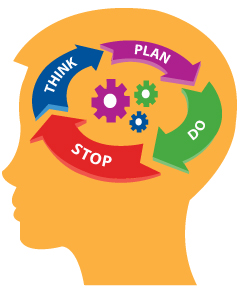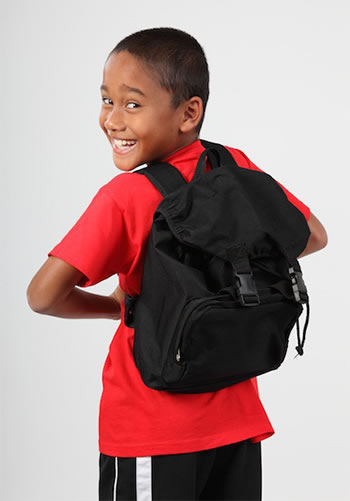By: Kelly Nesbitt, MOT, OTR/L
What is executive functioning?
Executive functioning refers to organizing, problem-solving, working memory, sequencing and efficient execution of ideas to complete a task. Executive functioning is a complex process involving good sustained attention, organization of ideas, inhibiting impulses, time management, and problem-solving (Calderon, 2011).
General functioning would be tough without these skills in everyday life. There are many strategies that Occupational Therapists can help a child improve their executive functioning skills to better participate in their daily routines, which will be discussed below.
When do kids need to use executive functioning skills?
As an OT, I look at executive functioning specific to how kids can execute their daily “occupations,” such as getting dressed, packing up their backpacks, completing their self-care routines, or completing a craft. Almost all tasks kids do during the day involve some executive functioning skills. For instance, when they encounter a problem, they must come up with a new idea, organize how to execute a plan, gather supplies needed, and adjust their plan if something new arises. Take the example of getting dressed in the morning, for example. When you tell your 7-year-old child, “Go get dressed before school,” your child must…
- Be regulated enough in their body to understand and process the verbal directions given to them. Do they know what “go get dressed before school” means?
- Have an idea of what they want to wear- Do they need shorts? Leggings? Jeans? Once they realize it’s cold outside, do they know the necessary steps to take?
- Visualize what supplies they need on a cold day: socks, shoes, underwear, a shirt and pants. They need to know where to go in the house to find all these supplies.
- Once they have this “list” of what they need, they need to gather these materials. Your child must be able to draw on their memory to know where do I find my clothes? My dresser? My closet?
- Then find all these articles of clothing in their room, keeping in mind everything they need and staying focused on this task (sustained attention) and getting it done in a reasonable amount of time before mom calls them to get in the car for school.
- If they find every article of clothing but realize that they cannot find their jeans, do they have a strategy to solve this issue? Can they ask Mom? Can they look in the laundry room if mom or dad has washed their jeans and it just hasn’t been put away yet?
- Once your child finds out that their jeans were just in their brother’s room, can they then sequence the steps accurately of dressing in their school clothes? (take off PJs, pull on their underwear, then pants, then their shirt)
- Be able to evaluate to see if the task was completed correctly. Did they forget a sock? Did they miss a step? Did they complete the task on time?
Needless to say, a lot of brain power actually goes into what seemingly is a simple task to most adults.
How do I know if my child has executive functioning difficulties?
A diagnosis like attention deficit hyperactivity disorder (ADHD) or autism can certainly be a factor, but there are many neurological, mental health and behavioral disorders that can affect a child’s executive functioning skills. An Occupational Therapist, Speech Pathologist or Social Worker, can help you determine if their difficulties are from executive functioning difficulties or if there are other sensory, postural, mental health, and/or motor planning issues underlying. Some signs that executive functioning may be hard for your child include (but are not limited to)….
- You have to constantly prompt kids to get dressed in the morning or walk them step-by-step through daily routines that you know they know how to do
- Your child consistently forgets their homework assignments at home, or their binder is so disorganized that they cannot find what they need in it
- Your child consistently forgets to do chores (not just avoiding them) or does them incompletely (when you know they understand what to do)
- They get distracted easily. You ask your child to do something, and you consistently find them doing something completely different (watching tv, playing with a different toy)
- Homework tasks are really hard (especially around 2nd grade, where the workload increases)
- Teachers have described them as “disorganized” or “getting distracted in class.”
Strategies to help:
Environmental setup:

- Keep the environment at home decluttered (as much as possible). Have designated spaces where toys belong that are denoted with labels (for kids that read) or pictures (for children who are not yet reading). I recommend taking literal pictures on your phone of what goes in the bin and printing it out so that your child makes the connection of what actual items go in that bin.
- For homework completion, you can have two bins at the table where the child does their homework, labeled “to do” and “done.” You can put all the papers the child must complete in the to-do bin, and as the child finishes each, they can move them to the “done” bin. Sometimes this concrete step helps a child’s brain visualize what is left to complete and what is already complete.
Visual schedules:
- Have a visual schedule of activities you want your child to complete. This schedule has small pictures that go in see-through sleeves. Once an activity is completed, the child can take the picture out of the sleeve and put it in a pouch at the bottom. Again, I’d recommend you take pictures of the child’s literal tasks/them doing the tasks to help improve comprehension of what the picture represents.
Timers:
Count “ups”/ Clocks– For children who both do and do not know how to tell time, I recommend using a clock to help them manage time. If you have an analog clock with a glass or plastic face, use Expo markers to draw pie segments on the clock face of what task you want the child to do.
For this example, if you need to be out the door by 3 o’clock, tell the child that they need to get dressed while the big hand is in the orange area. Children who can read can have more complex segments delineated on the clock for multi-steps.

Countdowns/timers:
Time Timer clocks count DOWN how much time is left, which can be helpful for children when it’s almost time to transition away from the TV or leave for school in the morning.
Executive Functioning Support
If you feel like your child is struggling consistently with executive functioning tasks, an Occupational Therapist can specifically look at these skills in an OT evaluation. Our skilled therapy team works across ages and diagnoses and can help create a personalized plan to help your child.
To learn more about services at Easterseals DuPage & Fox Valley, call us at 630.282.2022 or email info@eastersealsdfvr.org.
References:
Executive function in children: Why it matters and how to help – Harvard Health by Johanna Calderon, PhD 2011








